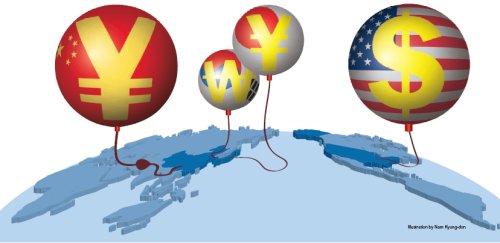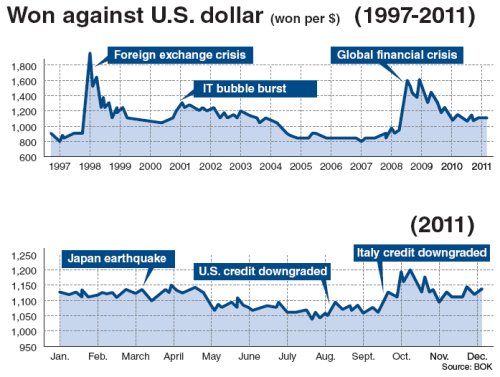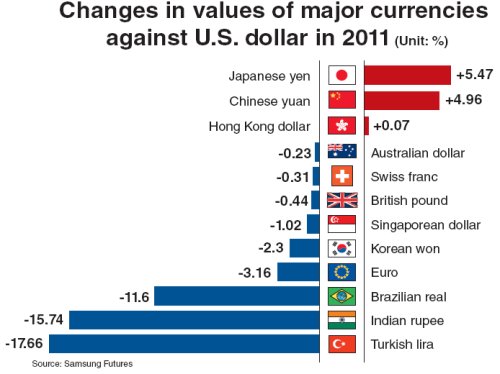
It has been a familiar year-end scene. Korean financial officials try to shore up the value of the nation’s currency to help local companies that settle accounts in December avoid exchange losses.
In the closing days of 2008, a year when the Korean won fell sharply against the U.S. dollar amid the global financial crisis, some foreign exchange dealers in Seoul were pressed to withdraw their orders to buy the greenback.
At the end of last year, however, financial authorities remained calm, seeing the local currency close at 1,151.80 won per dollar on Dec. 29, the last trading day of 2011.

The won had quickly recovered from its short, sharp decline against the dollar in the wake of the Dec. 19 announcement of the death of North Korean leader Kim Jong-il. The announcement by Pyongyang’s state media, which caught Seoul officials off-guard, caused the won to fall 1.4 percent to 1,174.8 won per dollar.
Putting officials further at ease, the volume of dollar transactions in the local currency market during the last days of the year remained at about half the usual level.
The won-dollar exchange rate steadily declined in the early part of 2011, before beginning to sharply increase in August as the global financial market became turbulent in the aftermath of the U.S. credit rating downgrade and worsening eurozone crisis.
The won, which stood at 1,135 to the dollar at the end of 2010, strengthened to 1,050 in July before dropping as low as 1,196 in September. Since advancing to around 1,110 in October, it remained stable until it was jolted again by the announcement of the North Korean dictator’s death.
Concerns over the exchange loss of some local companies with a large amount of foreign currency-denominated debt, which began to grow last autumn, were subdued at the end of the year.
Many currency experts and business leaders here agree that this year will see the won gain value against the greenback, probably via more volatile movement, trading between 1,025 and 1,150 won per dollar. They expect external uncertainties such as the debt woes in Europe might be eased in the first half, leading investors to turn to emerging markets.
Jung Dae-sun, a researcher at the Samsung Economic Research Institute, forecast the won would fall as low as 1,080 against the dollar in the first half before strengthening gradually to 1,040 in the second half.
In a recent survey of local company CEOs, 45 percent predict the won will trade between 1,050 and 1,100 and 39 percent expect it to move within the range of 1,100 to 1,150.
Strong fundamentals
The reasons cited by experts for a stronger won are similar to those that would have kept the won stable throughout last year other than the instability in the global financial market.
With the gradual containment of the eurozone crisis expected to stabilize the global financial market, the dollar will lose value, reflecting the weakened fundamentals of the U.S. economy such as the twin deficits in trade and budget, they note.
The continued easing of U.S. monetary policies ― including the measure to keep the benchmark interest rate near zero percent until mid-2013 ― will also serve to keep the greenback weak.
The fundamentals of the Korean economy will continue to remain strong, helping attract more capital inflows and thus boost the value of the won, experts say.
Korea is expected to continue its trade surplus this year, though the amount is estimated to decrease to $25 billion from $33.3 billion last year. Its national debt ratio to the nominal gross domestic product remains far below those for other advanced economies.
Last year’s expansion of currency swap deals with Japan and China to $70 billion and $56 billion, respectively, is also expected to help keep the won stable.
Economists note the government may take a different approach to the foreign exchange market, possibly in favor of a stronger won, which would help curb inflation by making imported goods cheaper.
The Bank of Korea said late last month that it would keep its “emphasis on firmly anchoring the basis for price stability.”
Experts note there are still external factors that could make the exchange rate volatile and push it up at least temporarily.
Korean financial officials have been sensitive to the volatile won-dollar exchange rate, which has often been the target of currency speculators at home and abroad. During the global financial crisis in 2008, Korea was one of the biggest victims as its currency lost 25.7 percent in value. Of the 32 major currencies, the Korean won ranked third after the South African rand and Brazilian real in terms of volatility during the turmoil, according to a report from the Korea Institute of Finance.
The lingering possibility of the global financial market being drawn into an intermittent instability in the process of overcoming the eurozone crisis could also cause the won to drop.
Currency frictions
The possible escalation of currency friction among major economic powers, especially between the U.S. and China, may further amplify the volatility, experts say.
With most countries exhausting effective policy measures to boost their economy, they are likely to be tempted into trying to increase exports by depreciating their currencies.
Jung said the possibility cannot be ruled out that currency friction between the U.S. and China may reach a flashpoint this year as the U.S. is holding presidential elections.
“It is difficult to measure the impact of the election factor but we need to be reminded that the latest currency war between the U.S. and other major countries broke out in October 2010 in the run-up to the U.S. congressional elections,” he said.

In 2011, the Japanese yen and Chinese yuan appreciated the most against the U.S. dollar while the Korean won and other Asian currencies depreciated.
According to figures from Samsung Futures, the yen and yuan appreciated 5.47 percent and 4.96 percent, respectively. The value of the won fell by 2.3 percent.
The U.S. did not see the appreciation of the yuan and yen as sufficient. In a semi-annual report in late December, the Treasury Department criticized China for not moving quickly enough to more exchange rate flexibility and chided Japan for intervening in the currency market to cap the yen’s rise.
The report said the pace of yuan appreciation has been too slow, calling it “insufficient.”
“The Treasury will closely monitor the pace of appreciation and press for policy changes that yield greater exchange rate flexibility, a level playing field and a sustained shift to domestic demand-led growth,” it said. But the U.S. again stopped short of labeling China a currency manipulator.
The decision by the U.S. not to designate China a currency manipulator, observers noted, reflected its tied hands in pressing China further on reforming the exchange rate system.
China, the biggest foreign holder of U.S. Treasuries, with about $1.1 trillion, has warned the U.S. not to “politicize” the currency issue.
The Chinese government made no official response to the Treasury Department report, but China’s state news agency said the decision sent a “clear and positive signal” that would soothe the market and benefit trade.
But pressure has mounted in Congress and among U.S. manufacturers for President Barack Obama to depart from his flexible approach and take a harder line.
Some U.S. politicians have argued that China has gained an unfair competitive edge in global markets by keeping the yuan artificially low to boost exports, resulting in a swelling U.S. trade deficit with China. Republican presidential front-runner Mitt Romney has vowed that as president he would strengthen tariff barriers to Chinese goods if China refuses to let its currency float further.
Taking Japanese officials aback, the report also criticized Tokyo for its unilateral interventions to sell the yen in August and October, following a joint Group of 7 action in the aftermath of the March 11 earthquake.
But Tokyo made it clear the report would not change its position. At the time, a Japanese official said, “This report does not make it more difficult for Japan to intervene. We are committed to doing whatever is necessary.”
The report also urged Korea to limit such interventions to “exceptional circumstances of disorderly market conditions and adopt a greater degree of exchange rate flexibility.”
Days after the report was released, China’s central bank governor hinted at loosening the state grip on the yuan by widening its trading band. The yuan is currently allowed to trade 0.5 percent on either side of a midpoint price set by the central bank every trading day.
“In terms of future direction, exchange rate fluctuations will widen,” Zhou Xiaochuan, governor of the People’s Bank of China, said in an interview with a Chinese weekly magazine.
Analysts viewed Zhou’s comment as indicating the yuan, which a U.S. think tank recently estimated was undervalued by 24 percent against the dollar, may fluctuate further in the future but not necessarily appreciate as demanded by China’s trading partners including the U.S.
Yuan as reserve currency
The gradual appreciation of the yuan also seems to be in line with Beijing’s long-term goal to internationalize the Chinese renminbi with the aim of making it another reserve currency competing with, or eventually replacing the U.S. dollar.
China has made unprecedented efforts to develop its currency into an international reserve currency with controlled convertibility through the parallel development of the onshore and offshore renminbi markets.
With its growth slowing, some have raised questions on whether the internationalization of the renminbi could be stalling. Renminbi payments volumes fell for two consecutive months in September and October, ranking 17th on the world currency league table.
But most experts indicate that the expansion of its economy and trade volume, whose sizes are estimated to be about 40 percent larger than America’s by 2020, and the growing need to open up its financial system to avoid further losses in the future will boost the yuan to the status of a reserve currency, regardless of when it is achieved.
Lee Sung-han, president of the Korea Center for International Finance, said the emergence of the yuan as an international reserve currency poses both opportunities and risks for Korea.
He said it could make it easier for Korean companies to deal with Chinese partners, helping expand their advancement into the Chinese market. Korean exporters would also be exposed to less risk of currency values changing.
“But Korea would have to be cautioned against depending too much on China and being swayed by changes in China’s economic policies,” said Lee.
By Kim Kyung-ho (khkim@heraldcorp.com)
-
Articles by Korea Herald










![[Hello India] Hyundai Motor vows to boost 'clean mobility' in India](http://res.heraldm.com/phpwas/restmb_idxmake.php?idx=644&simg=/content/image/2024/04/25/20240425050672_0.jpg&u=)









